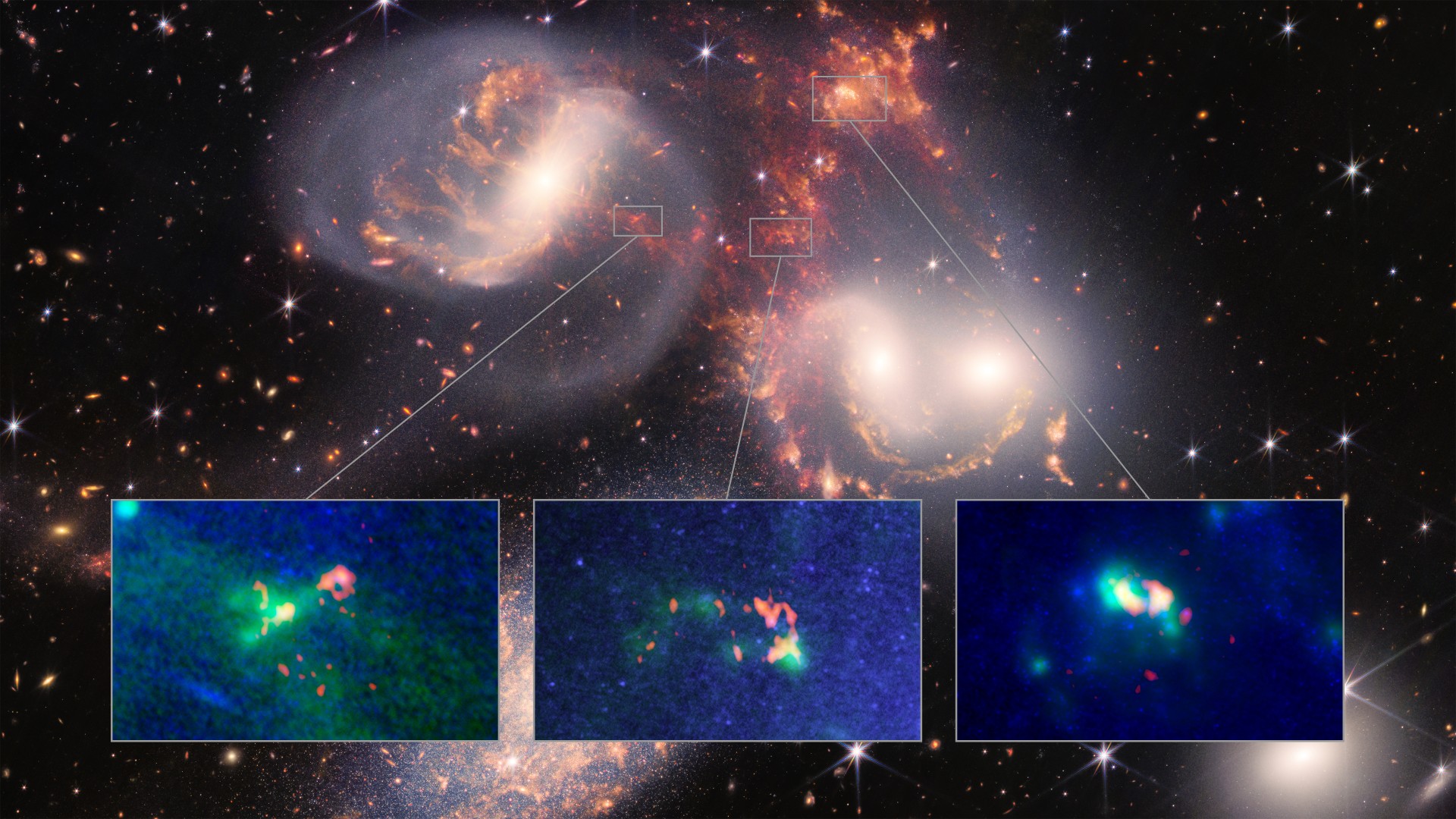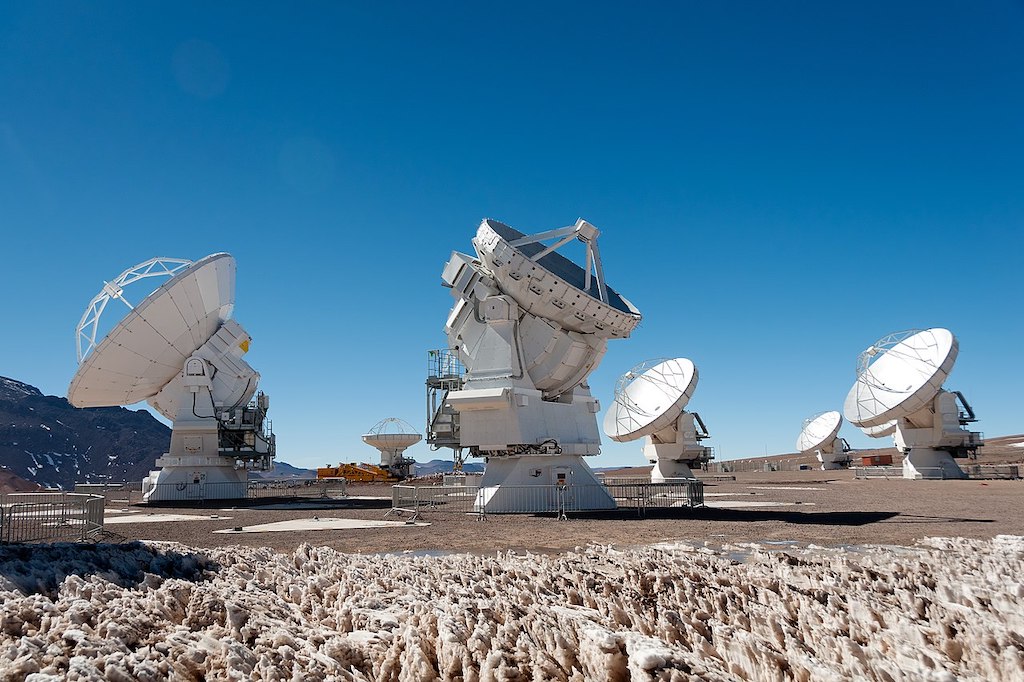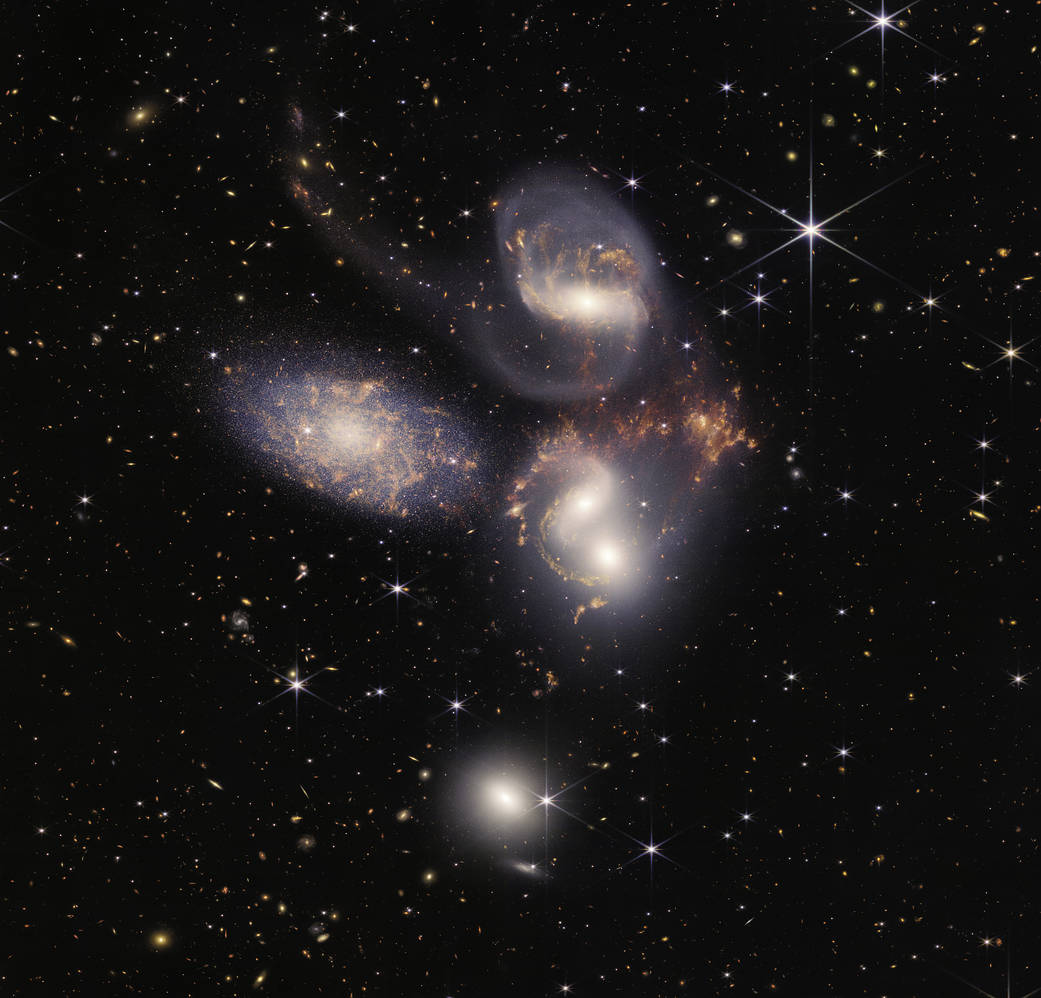James Webb Space Telescope spies massive shockwave and baby dwarf galaxy in Stephan's Quintet
A shockwave traveling through Stephan's Quintet at over a million miles per hour is causing turbulence in between its five galaxies.

Shockwaves created by a collision between the galaxies of Stephan's Quintet and an intruder galaxy are driving strange processes in the intergalactic medium, the tenuous clouds of warm-to-hot hydrogen plasma that exist in the space between galaxies.
New observations made with the James Webb Space Telescope (Webb or JWST) and the Atacama Large Millimeter/submillimeter Array (ALMA) provided astronomers with a good view of intruder galaxy NGC 7318b as it violently forces its way into this group of galaxies at a relative speed of around 1.8 million mph (approximately 800 kilometers per second). That's fast enough to travel from Earth to the moon and back again in just over 15 minutes.
This violent invasion of Stephan's Quintet is triggering a shockwave several times as large as the Milky Way that is rippling through the interstellar plasma and kickstarting a "recycling plant" for warm and cold molecular hydrogen gas between the five galaxies. In addition, astronomers found a giant cloud of gas breaking apart to form a less-dense "fog" of warm gas; the JWST/ALMA observations also show a tail of warm gas forming from what might be a collision between two clouds, and even the formation of a new galaxy.
Related: James Webb Space Telescope's best images of all time (gallery)
The discovery of these phenomena could help scientists better understand how turbulence influences the intergalactic medium and how collisions affect the formation of stars and the evolution of galaxies in general.
"As this intruder crashes into the group, it is colliding with an old gas streamer that likely was caused by a previous interaction between two of the other galaxies, and is causing a giant shockwave to form," Philip Appleton, lead astronomer on the project and Caltech's Infrared Processing and Analysis Center (IPAC) senior scientist, said in a statement.
"As the shockwave passes through this clumpy streamer, it is creating a highly turbulent, or unsteady, cooling layer, and it's in the regions affected by this violent activity that we're seeing unexpected structures and the recycling of molecular hydrogen gas," Appleton said. "This is important because molecular hydrogen forms the raw material that may ultimately form stars, so understanding its fate will tell us more about the evolution of Stephan's Quintet and galaxies in general."
Breaking space news, the latest updates on rocket launches, skywatching events and more!
Located around 270 million light-years from Earth in the constellation Pegasus, Stephan's Quintet is comprised of the galaxies NGC 7317, NGC 7318a, NGC 7318b, NGC 7319 and NGC 7320. The five galaxies have proved to be the ideal lab to study galactic interactions, including violent collisions, and how these interactions influence their environments.
But Stephan's Quintet differs from other sites of galactic collisions because these mergers usually trigger bouts of intense star formation, which isn't occurring in these five galaxies. Instead, in Stephan's Quintet the turbulence of these galactic collisions are being felt in the intergalactic medium, where there is not enough raw material to trigger star birth.
This means collision-triggered turbulence is not being hidden by star formation, meaning astronomers get an unobscured view of NGC 7318b as it rapidly breaks into Stephan's Quintet.
Taking advantage of this opportunity, Appleton and the team zoomed in on three key regions in Stephan's Quintet using ALMA, an astronomical interferometer of 66 radio telescopes in the Atacama Desert region of northern Chile. The observations allowed the astronomers to build the first-ever clear picture of how the hydrogen gas is continually moved and shaped.
"The power of ALMA is obvious in these observations, providing astronomers new insights and better understanding of these previously unknown processes," Joe Pesce, ALMA program officer at the U.S. National Science Foundation, said in the same statement.
Read more: 8 Cool Facts About the ALMA Telescope

Investigating three regions of turbulence
At the heart of the main shockwave, a region designated Field 6, a giant cloud of cold molecules is being broken down and reshaped into a tail of warm molecular hydrogen. As the same processes continue, the hydrogen is recycled through the same temperature phases repeatedly.
"What we're seeing is the disintegration of a giant cloud of cold molecules in super-hot gas, and interestingly, the gas doesn't survive the shock, it just cycles through warm and cold phases," Appleton said. "We don't yet fully understand these cycles, but we know the gas is being recycled because the length of the tail is longer than the time it takes for the clouds it is made from to be destroyed."
This hydrogen "recycling plant" isn't the only strange phenomenon these shockwaves are triggering. In a region called Field 5, the team spotted two cold clouds of gas linked by a stream of warm molecular hydrogen gas. One of the clouds has a bullet-like shape and is punching through this filament, giving rise to a ring-like structure.
"A molecular cloud-piercing through intergalactic gas, and leaving havoc in its wake, may be rare and not yet fully understood," Bjorn Emonts, an astronomer at the National Radio Astronomy Observatory (NRAO) and project co-investigator, said in the same statement. "
But our data show that we have taken the next step in understanding the shocking behavior and turbulent life-cycle of molecular gas clouds in Stephan's Quintet."
Of the regions investigated by the team, Field 4 seems to be the most "normal" and serene, hosting a less turbulent environment that has seen hydrogen gas collapse to trigger the creation of a disk of stars. The team believes that this marks the beginning of a small dwarf galaxy forming in Field 4.
"In Field 4, it is likely that pre-existing large clouds of dense gas have become unstable because of the shock, and have collapsed to form new stars as we expect," Pierre Guillard, a researcher at the Institut d'Astrophysique de Paris in France and a project co-investigator, said in the same statement. "The shock wave in the intergalactic medium of Stephan's Quintet has formed as much cold molecular gas as we have in our own Milky Way, and yet, it forms stars at a much slower rate than expected."
Guillard believes these new observations have significant implications for theoretical models of the impact of turbulence in the universe. He added, however, that additional work will be needed to understand the effect of high-level turbulence and how hot and cold gas mixes.
While JWST images of Stephan's Quintet combined with ALMA's observations delivered a wealth of information regarding the relationship between the cold, warm molecular, and ionized hydrogen gases in the wake of the giant shockwave, the team will have to turn to spectroscopic data to reach a more complete understanding of the region.
"These new observations have given us some answers, but ultimately showed us just how much we don't yet know," Appleton said. "While we now have a better understanding of the gas structures and the role of turbulence in creating and sustaining them, future spectroscopic observations will trace the motions of the gas through the doppler effect, tell us how fast the warm gas is moving, allow us to measure the temperature of the warm gas, and see how the gas is being cooled or warmed by the shockwaves. Essentially, we've got one side of the story. Now it's time to get the other."
The team's findings were presented at the 241st meeting of the American Astronomical Society on Monday (Jan. 9).
Follow us on Twitter @Spacedotcom or on Facebook.

Robert Lea is a science journalist in the U.K. whose articles have been published in Physics World, New Scientist, Astronomy Magazine, All About Space, Newsweek and ZME Science. He also writes about science communication for Elsevier and the European Journal of Physics. Rob holds a bachelor of science degree in physics and astronomy from the U.K.’s Open University. Follow him on Twitter @sciencef1rst.

